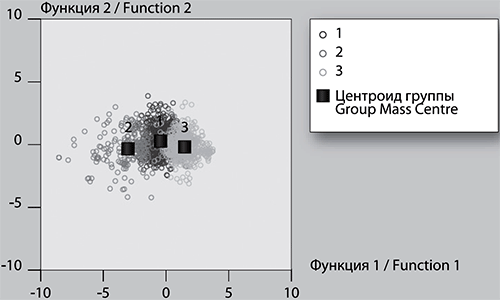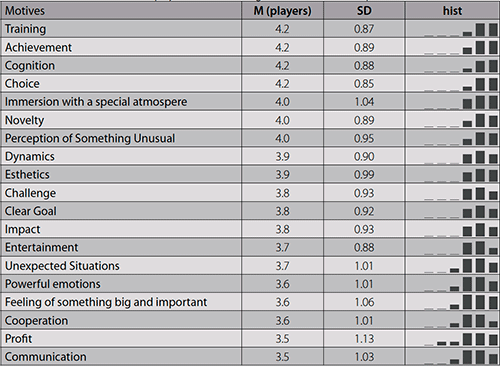Empirical study of explicit real-life motives in male gamers
Recieved: 08/31/2018
Accepted: 11/02/2018
Published: 12/30/2018
p.: 16-26
DOI: 10.11621/npj.2018.0402
Keywords: gaming; male gamers; motivation; explicit motives
Available online: 30.12.2018
Ivanova Nadezhda A.. Empirical study of explicit real-life motives in male gamers. // National Psychological Journal 2018. 4. p.16-26. doi: 10.11621/npj.2018.0402
Copied to Clipboard
CopyAbstract
Background. Psychological characteristics of gamers (video games players) is an extremely relevant field of research today, because prevalence of gaming is wide and growing, covering all current generations (Avetisova, 2011; Bogacheva, Voiskunsky, 2014; Snodgrass et al., 2017).
Objective. The study reveals the explicit real-life motives in online gamers and the reasons why they choose certain leisure compared to other passtimes.
Design. The sample includes 10,916 Russian-speaking gamers from Russia, Ukraine, Belarus and other CIS countries. The main explicit motives in the real-life gamers are considered: motives of cognition and motives of achievements. The discriminant analysis method identified and described three groups of players: with motives of cognition and motives of achievements of a rational type, motives of cognition and motives of achievements of an indefinite type. A comparison was made between male gamers and male non-gamers according to the degree of explicit motives. High mean on the Likert scale are observed in non-gamers within motives associated with communication and interaction with other people (Wilcoxon test, p≤0.01) and in motives aimed at perception of beauty, significance and grandeur (Wilcoxon test, p≤0,001). The gamers have a higher assessment of situations related to the clarity of the tasks, and perform significantly less interest in situations within which they can influence something (Wilcoxon test, p≤0.01).
Research Results. A scale for assessing real-life motives is designed to estimate the empirically identified motives in gamers on multiple choice scales and then on a five-point Likert scale. There are three groups of gamers with different types of motivation have been identified and described, a comparison of the severity of these motives in male gamers and male non-gamers has been made.
Conclusion. Cognitive motives and motives of achievement for male gamers and male non-gamers were expressed in equally high figures, which may be due to the universality and significance of the values of knowledge and achievements in modern society. Perhaps computer games are the most available leisure to gamers that satisfy their needs for cognition and achievement. A further task is set to test these assumptions using other methods (for example, in-depth interviews).

Fig. 1. Three groups of players based on motivation using discriminant analysis (canonical discriminant functions)
Table 1. Real life motives in the players of the online games World of Warships (N=1474)
Table 2. Grouping players using discriminant analysis
|
Groups |
Discriminant function |
|
|
1 |
2 |
|
|
1. N=599 |
-,416 |
,303 |
|
2. N=234 |
-3,009 |
-,331 |
|
3. N= 628 |
1,518 |
-,166 |
Table 3. Explicit motives in male gamers (N=308), and male non-gamers (N=192)
|
Motives |
M (non players) |
SD |
М (players) |
SD |
|
Training |
4.0* |
0.90 |
3.8* |
1.00 |
|
Achievement |
4.4 |
0.77 |
4.2 |
0.88 |
|
Cognition |
4.2 |
0.78 |
4.2 |
0.88 |
|
Choice |
4.2* |
0.86 |
3.9* |
0.99 |
|
Immersion with a special atmospere |
4.1* |
0.75 |
3.9* |
0.94 |
|
Novelty |
3.7* |
0.91 |
3.5* |
1.02 |
|
Perception of Something Unusual |
3.8* |
1.00 |
3.5* |
1.16 |
|
Dynamics |
4.2 |
0.73 |
4.2 |
0.87 |
|
Esthetics |
3.8 |
1.04 |
3.6 |
0.97 |
|
Challenge |
3.9 |
0.85 |
3.8 |
0.91 |
|
Clear Goal |
3.9 |
0.78 |
3.9 |
0.88 |
|
Impact |
3.6* |
0.88 |
3.8* |
0.94 |
|
Entertainment |
4.2* |
0.83 |
3.8* |
1.05 |
|
Unexpected Situations |
3.9* |
0.89 |
3.5* |
1.06 |
|
Powerful emotions |
4.0* |
1.01 |
3.5* |
1.05 |
|
Feeling of something big and important |
3.7 |
1.14 |
3.9 |
1.04 |
|
Cooperation |
4.3 |
0.82 |
4.2 |
0.87 |
|
Profit |
3.7 |
0.87 |
3.7 |
0.90 |
|
Communication |
3.5 |
0.91 |
3.6 |
1.05 |
|
Mean Age |
35.4 |
11.93 |
37.8 |
9.05 |
* Significance was determined using the Wilcoxon test adjusted for continuity.
References:
Ananiev B.G. (2001). Man as a subject of knowledge. St. Petersburg, Piter.
Avetisova A.A. (2011). Psychological features of players in computer games. [Psikhologiya. Zhurnal Vysshey Shkoly Economiki], 8(4), 35–58.
Bogacheva N.V., & Voiskunsky A.E. (2014). Specific features of cognitive styles and control functions for gamers. [Psikhologicheskie issledovaniya], 7(38), 1.
Bowman, N. D., Kowert, R., & Ferguson, C. J. (2015). The Impact of Video Game Play on Human (and Orc) Creativity. Chapter in book Video Games and Creativity. Elsevier inc. doi: 10.1016/B978-0-12-801462-2.00002-3
Brunstein J. C., Schmitt С. H. (2004). Assessing individual differences in achievement motivation with the Implicit Association Test. Journal of Research in Personality, 38(6), 536–555. doi: 10.1016/j.jrp.2004.01.003
Buelow, M.T., Okdie, B. M., Cooper, A. B. (2015). The influence of video games on executive functions in college students. Computers in Human Behavior, 45, 228–234. doi: 10.1016/j.chb.2014.12.029
Demetrovics Z., Urban R., Nagygyorgy K., Farkas J., Zilahy D., Mervo B., Reindl A., Agoston C., Kertesz A., & Harmath E. (2011). Why do you play? The development of the motives for online gaming questionnaire (MOGQ). Behavior Research Methods, 43(3), 814–825. doi: 10.3758/s13428-011-0091-y
Evans M. A., Norton A. Chang M., Deater-Deckard K., & Balci O. (2013). Youth and video games-Exploring effects on learning and engagement. Zeitschrift für Psychologie. Journal of Psychology, 221(2), 98–106. doi: 10.1027/2151-2604/a000135
Ferguson C.J., Garza A., Jerabeck J., Ramos R., & Galindo M. (2013). Not Worth the Fuss After All? Cross-sectional and Prospective Data on Violent Video Game Influences on Aggression, Visuospatial Cognition and Mathematics Ability in a Sample of Youth. Journal of Youth and Adolescence, 42(1), 109–122. doi: 10.1007/s10964-012-9803-6
Gabbiadini, A., & Greitemeyer, T. (2017). Uncovering the association between strategy video games and self-regulation: A correlational study. Personality and Individual Differences.Volume, 104, 129–136. doi: 10.1016/j.paid.2016.07.041
Granic, I., Lobel, A., & Engels, R. C. M. E. (2014). The Benefits of Playing Video Games. American Psychologist, 69(1), 66–78. doi: 10.1037/a0034857
Hainey, T., Connolly,T., Stansfield, M., & Boyle, E. (2011). The differences in motivations of online game players and offline game players: A combined analysis of three studies at higher education level. Computers and Education, 57(4), 2197–2211. doi: 10.1016/j.compedu.2011.06.001
Harrington, B., & O’Connell, M. (2016). Video games as virtual teachers: Prosocial video game use by children and adolescents from different socioeconomic groups is associated with increased empathy and prosocial behavior. Computers in Human Behavior, 63, 650–658. doi: 10.1016/j. chb.2016.05.062
Ivanova N.A., Artemov A.V., Volokhonsky V.L., & Dubik S.V. (2016). Motivation for online gaming in the context of the theory of self-determination (SDT). [Vestnik St. Petersburgskogo Universiteta]. Series 16. Psychology. Pedagogy, 2, 47–58.
Ivanova N. A., Ledovaya Y. A., & Artemov A. V. (2016). Real-life learning motives ща online games players. [Sed’maya mezhdunarodnaya konferentsiya po kognitivnoy nauke. Tezisy dokladov], 45–46.
Koroleva N.N. (2011). The Expansion of Virtuality. [Universum: Vestnik Gertsenovskogo Universiteta], 9, 76–78.
Kruglov V.G. (2007). Implicit and explicit values in the general scheme of analysis. [Vestnik St. Petersburgskogo Universiteta]. Series 16. Psychology. Pedagogy. 2, Part 1, 139–149.
King D. L., & Delfabbro P.H. (2014). The cognitive psychology of Internet gaming disorder. Clinical Psychology Review, 34, 298–308. doi: 10.1016/j. cpr.2014.03.006
Koroleva N.N. (2011). The Expansion of Virtuality. [Universum: Vestnik Gertsenovskogo Universiteta], 9, 76–78.
McClelland, D. C., Koestner, R., & Weinberger, J. (1989). How do self-attributed and implicit motives differ? Psychol. Rev., 96, 690–702.
Prot, S., Anderson, C. A., Gentile, D. A., Brown, S. C., & Swing, E. L. (2014). The positive and negative effects of video game play, In A. Jordan & D. Romer (Eds.). Media and the Well-Being of Children and Adolescents. New York: Oxford University Press, 109-12.
Przybylski, A. K., & Weinstein, N. (2017). A Large-Scale Test of the Goldilocks Hypothesis: Quantifying the Relations Between Digital-Screen Use and the Mental Well-Being of Adolescents. Psychological Science, 28(2), 204–215. doi: 10.1177/0956797616678438
Sevin, R., & De Camp, W. (2016). From playing to programming: The effect of video game play on confidence with computers and an interest in computer science. Sociological Research Online, 21(3), 31. Article number 16. doi: 10.5153/sro.4082
Sjoblom, M. (2017). Why do people watch others play video games? An empirical study on the motivations of Twitch users. Computers in Human Behavior, 75, 985–996. doi: 10.1016/j.chb.2016.10.019
Snodgrass, J. G., Dengah, H.J. F., Lacy M. G., Bagwell A., Van Oostenburg M., & Lende, D. (2017). Online gaming involvement and its positive and negative consequences: A cognitive anthropological “cultural consensus” approach to psychiatric measurement and assessment, Computers in Human Behavior, 66, 291–302.
Soldatova G.U., & Teslavskaya O.I. (2017). Video games, academic performance and attention: the experience and results of foreign empirical studies of children and adolescents. [Sovremennaya zarubezhnaya psikhologiya], 6(4), 21–28.
Sublette, V. A., & Mullan, B. (2012). Consequences of Play: A Systematic Review of the Effects of Online Gaming. International Journal of Mental Health and Addiction, 10(1), 3–23. doi: 10.1007/s11469-010-9304-3
Uttal, D. H., Meadow, N. G., Tipton, E., Hand, L. L., Alden, A. R., Warren, C., & Newcombe, N. S. (2013). The malleability of spatial skills: A meta-analysis of training studies. Psychological Bulletin, 139, 352–402. doi: 10.1037/a0028446
Voyskunsky A.E. (2017). Areas of research mediated Internet activities. [Vestnik Moskovskogo Universiteta], Series 14. Psychology, 1, 51–66.
Yee, N. (2007). Motivations for Play in Online Games. CyberPsychology and Behavior, 9(6), 772–775. doi: 10.1089/cpb.2006.9.772
Yee, N., Ducheneaut, N., & Nelson, L. (2012). Online Gaming Motivations Scale. Development and Validation, Proceedings of CHI, 2803–2806. doi: 10.1145/2207676.2208681
Zimbardo F., & Colombe N. (2017). Man in isolation. Games, porn and loss of identity. Moscow, Alpina Publisher.Ivanova Nadezhda A.. Empirical study of explicit real-life motives in male gamers. // National Psychological Journal 2018. 4. p.16-26. doi: 10.11621/npj.2018.0402
Copied to Clipboard
Copy

